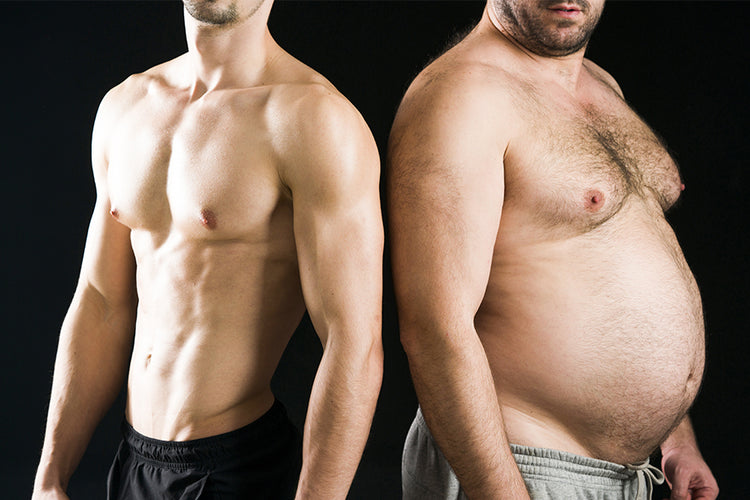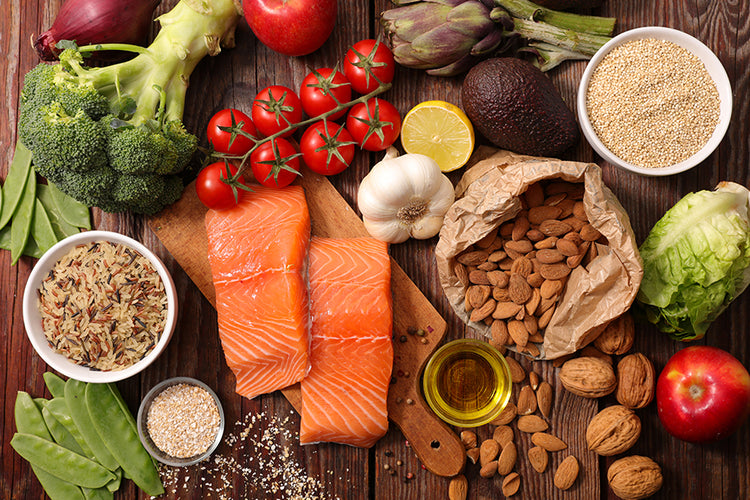Once upon a time, in a land far, far away, people believed that the key to losing weight was simply to eat less and exercise more. They huffed and puffed on treadmills, ate nothing but carrot sticks, and still couldn't figure out why they weren't shedding those extra pounds.
Little did they know, there was a secret they were missing out on. There could be some magical ingredients that would help them achieve their dream body with half the effort! And those magical ingredients, my dear friends, are developing a proper diet and exercise routine. Yes, you read that right- no quick fixes around here.
Nowadays, it seems like everyone is trying to sell you a quick fix or a magic pill, but what if I told you that the solution to your weight loss woes was right in front of you all along? Get ready to laugh, eye-roll, and learn a thing or two as we explore the wonderful world of using the fundamentals of diet and exercise to achieve your fitness goals.
Related Article: Want to Lose Belly Fat? 10 Healthy Tips
Objectives
Establishing objectives beforehand is essential to initiate a weight loss program. These objectives could entail losing weight or reaching a particular body shape, such as abs.
Setting a realistic timeline to attain these objectives is crucial, whether shedding a specific number of pounds or acquiring a specific look. Without a deadline, there will be no pressing need to advance and make progress.
Rate of Progress
The pace at which progress can be achieved varies significantly between fat loss and muscle growth. While building muscle is gradual, fat loss can occur quite rapidly. You can also take a Fat Burner to reduce fat and achieve health with fitness. We've all seen advertisements claiming to help you lose 10-20 pounds in just a few weeks.
However, we're aiming for a better outcome than this. If weight is lost too quickly, muscle loss may occur, resulting in a slower metabolism, an unappealing physique, compromised health, and an increased likelihood of regaining weight.
It is recommended to choose a weight loss of 1-2 pounds per week on any fat loss program. This pace of progress ensures that only fat is lost and not muscle tissue and it also avoids a metabolism stall and ensures continuous progress.
A Personalized Approach
As you peruse this guide, you will notice a recurring theme: achieving optimal fat loss requires a personalized approach. A one-size-fits-all strategy will not suffice if you desire the most significant outcomes.
Developing a successful plan necessitates considering various factors. This guide will educate you on how to customize your approach based on your unique body type.
Important Terms You Need to Know About Fat Loss
When it is about losing fat, there are several key terms you need to understand to achieve your weight loss goals. Understanding these terms and how they relate to fat loss can help you develop a successful weight loss plan that works for you.
- Calories: Calories quantify the energy value present in food. Any surplus calories that remain unused get stored in the body as fat.
- Micronutrients: Micronutrients are vital nutrients the body only requires in trace amounts. Examples of micronutrients include vitamins and minerals.
- Amino Acids: Amino acids are the building blocks of proteins. Proteins consist of different amino acids in varying amounts and types.
- Glycogen: Glycogen is a carbohydrate that the human body stores. When we consume carbohydrates, they get converted to glycogen and stored in the liver and muscle tissues. Glycogen serves as a primary source of energy for the body.
- Metabolic Rate: The pace at which the body uses energy is called the metabolic rate. A higher metabolic rate implies that the body consumes energy more rapidly, leading to a leaner physique.
- Protein Synthesis: The action in which amino acids get arranged into proteins is called protein synthesis. Muscle growth occurs through protein synthesis.
- Anabolic (Anabolism): Anabolic refers to the state of muscle growth. When muscles are being built, the body is in an anabolic state.
- Catabolic (Catabolism): Catabolic refers to the state of muscle breakdown. If muscles are being lost, the body is in a catabolic state.
- Aerobic: Aerobic exercises require oxygen to be present while working out.
- Anaerobic: Anaerobic exercises do not require the presence of oxygen while working out.
- Substrate: Any substance or material an enzyme acts upon is called a substrate.
Finding Out Your Body Type

The success of your fat loss journey depends on considering your body type in both diet and exercise. As different body types have unique requirements for calorie intake, macronutrient composition, and training intensity, it's crucial to identify your body type before deciding on your dietary and workout strategies. Therefore, it's imperative to determine your body type to tailor your caloric intake and training volume accordingly.
Ectomorphs
Ectomorphs, called ectos, are characterized by their slender physique and narrow bone structure, evident in their small rib cage, narrow shoulders, and long, thin limbs.
Due to their body type, ectos typically find it challenging to gain muscle and fat; hence, putting on body weight is a gradual process. However, their fast metabolism gives them an upper hand in achieving a lean body.
Mesomorphs
Mesomorphs, also known as mesos, are regarded as lucky owing to their natural athletic appearance, even without much training.
Their broad shoulders and comparatively narrower waists are their key features, and they have the advantage of building muscle and losing fat with ease, thanks to their genetic makeup. Yet, mesos must adhere to a proper workout regimen and diet to maintain their shape.
Endomorphs
Endomorphs, or endos for short, have a broader bone structure than ectomorphs, with their wide rib cages, shoulders, and waistlines. Due to their body type, endos put on both muscle and fat quickly, making it challenging to maintain a lean physique.
Nonetheless, their body's ability to build and preserve muscle tissue proves advantageous when losing fat, although it requires effort to get lean.
Calories and Macronutrients
To lose fat effectively, it is crucial to understand the three macronutrients-protein, carbohydrates, and fat-as they perform specific bodily functions.
Therefore, it is essential to consume them in appropriate amounts. Moreover, body type also influences how the body responds to these nutrients, and hence, different body types require varying recommendations for each macronutrient and calorie intake.
Thus, gaining knowledge about these nutrients and their impact on the body is crucial for successful fat loss.
Calories
While most people are familiar with the term "calories," not many understand its precise meaning; calories measure the energy content of food, indicating how much energy the body can obtain from consuming it.
Every day, the body utilizes a specific number of calories as energy and any excess calories are stored as body fat. Conversely, if you consume fewer calories than your body requires, it will use stored body fat to meet its energy needs.
All three macronutrients - protein, fat, and carbohydrates - contain calories, with one gram of protein containing 4 calories, one gram of fat containing 9 calories, and one gram of carbohydrate contains 4 calories.
However, calorie requirements vary depending on body type:
- Ectomorphs need to consume body weight x 16-18 calories
- Mesomorphs requiring body weight x 14-17 calories
- Endomorphs require bodyweight x 12-15 calories
The body processes calories from protein, carbohydrates, and fat differently. Hence, it is critical to understand the role of each macronutrient in the body to ensure effective fat loss.
Proteins
Proteins are essential to the human body due to their various functions. Contractile proteins are used for muscle contraction, while enzymes cause chemical reactions within the body. Some proteins can also be used for energy.
Maintaining muscle tissue is crucial in any fat-loss plan, so protein is necessary. You can add Whey Protein Supplements to multiply protein concentration in your body. After ingestion, the body breaks down protein into amino acids that are transported to cells in the bloodstream.
Rather than using protein for energy, the body prefers to store it as muscle tissue. Glucogenesis, the process of synthesizing glucose from protein breakdown, can lead to muscle tissue breakdown and is not ideal for maintaining muscle mass.
Moreover, proteins produce less energy per unit compared to carbohydrates or fat. Therefore, protein should be used mainly as a building block instead of being used for energy.
The recommended protein intake should vary depending on the body type to achieve fat loss goals. The following guidelines are suggested for protein intake:
- Ectomorph: x body weight by 1.0-1.2 grams
- Mesomorph: x body weight by 1.1-1.3 grams
- Endomorph: x body weight by 1.1-1.4 grams
Fats
Dietary fats are crucial molecules that play essential roles in various bodily processes, making it impossible to ignore them when planning for fat loss. Fat is the most energy-dense nutrient, containing 9 calories per gram compared to 4 calories per gram in protein and carbs. However, the downside to fat is that it is easily stored as adipose tissue or body fat.
Fat also plays a vital role in testosterone production. In a fat-loss diet, testosterone levels naturally decrease as calorie intake is restricted. This is because the body conserves energy and reduces muscle growth.
Fatty acids are a substrate for cholesterol, eventually converted to testosterone. If fat intake is too low, enough fatty acids will not be available for optimal testosterone production, further reducing testosterone levels.
Once a specific fat intake is reached, fats do not serve as many functions as protein and carbs. Since fats are more calorie-dense than protein and carbs, they are easier to cut when focusing on fat loss. However, it is essential to cut fat intake while ensuring that daily intake does not drop too low to affect testosterone levels negatively.
Different body types have different recommendations for fat intake based on body weight to determine how much fat is needed for fat loss. Ectomorphs, Mesomorphs, and Endomorphs have different daily fat intake recommendations based on their body weight.
Ectomorph Bodyweight and Intake
100-150 lbs = 45-50 grams per day
150-200 lbs = 50-55 grams per day
200 lbs. and over = 55-60 grams per day
Mesomorph Bodyweight and Intake
100-150 lbs = 40-45 grams per day
150-200 lbs = 45-50 grams per day
200 lbs. and over = 50-55 grams per day
Endomorph Bodyweight and Intake
100-150 lbs = 50-55 grams per day
150-200 lbs = 55-60 grams per day
200 lbs. and over = 60-65 grams per day
Carbohydrates
Carbohydrates, commonly known as carbs, are a vital macronutrient our body needs for energy. When we consume carbohydrates, our body breaks them down into sugars, which are then used to produce glucose. Glucose is the primary energy source that fuels our brain, muscle tissue, and organs
To ensure that our body has enough glucose to function, it converts the excess glucose into glycogen and stores it in our muscles. This stored glycogen is an energy source during physical activities such as weight training.
Our body uses ATP (Adenosine triphosphate) during weight training for energy. Our body utilizes the glycolytic pathway to replenish ATP, which converts glucose into ATP.
Glucose, a carbohydrate type, is obtained from the bloodstream or the glycogen stored in our muscles. Therefore, carbohydrates are essential for weight training as they are the primary fuel for working muscles.
If our body does not get enough carbohydrates, it will convert amino acids into glucose to fulfil its energy needs. Amino acids are the building blocks of proteins and are usually stored in our bodies as proteins.
This process can harm muscle growth and lead to muscle loss. Carbohydrates are anti-catabolic, which means they spare proteins from being broken down into glucose for energy.
Apart from providing energy, carbohydrates are also crucial for maintaining a fast metabolism. Leptin, a critical hormone in fat-burning, is directly related to carbohydrate intake and body fat levels.
When we consume high-carbohydrate foods, leptin levels in our body increase, which signals to our brain that we are in a fed state. This causes our metabolism to remain high, leading to an increased calorie-burning rate.
In contrast, when we consume low-carbohydrate foods, our body's leptin levels decrease, which sends signals to our body that we are in a state of energy depletion.
As a result, our body compensates by lowering our metabolism rate to conserve energy. By consuming an adequate amount of carbohydrates, we can maintain elevated levels of leptin and other fat-burning hormones even when our total calorie intake is low.
Carbohydrates also play a critical role in regulating muscle cell volume. When we consume low-carbohydrate foods, our muscles appear flat and smaller because the restricted carbohydrate intake diminishes cell volume.
Carbohydrates are stored in our muscle tissue as glycogen, and each gram of glycogen is stored with 2.7 grams of water. Hence, restricting our carbohydrate intake can drastically affect the size of our muscle cells.
When our muscle cells are depleted due to low-carbohydrate intake, our body perceives this as a shortage of food, which leads to a decrease in fat-burning hormones.
On the other hand, when we consume an adequate amount of carbohydrates, it signals our body that we are in a fed state, which results in a higher metabolism rate.
Cell volume is also a primary determinant of protein synthesis, which is the action by which our body builds and repairs muscles. When our muscle cells are total and appear to be in a fed state, protein synthesis is higher than when our muscles are depleted and starved for glycogen.
Insulin
Insulin, a hormone released in response to carbohydrate consumption, plays a vital role. Although insulin has been criticized for inhibiting fat loss, it has significant muscle growth and retention benefits.
Insulin is one of the human body's most anabolic/anti-catabolic hormones, binding with the muscle cell membrane to trigger growth reactions. Additionally, it keeps cortisol, a catabolic hormone that breaks down muscle tissue, at bay. When insulin levels are high, cortisol levels are low, leading to muscle retention.
While it is essential to keep insulin levels in check to optimize fat loss, it is equally important not to avoid carbohydrates altogether, as they provide numerous benefits in terms of muscle retention.
Preferred Food Choices

Knowing how much to eat daily and which foods to choose is essential to optimize your diet. While the amount you eat is more important than the type of food for fat loss and muscle growth goals, food choices can help optimize overall health.
Consuming adequate protein is crucial for muscle building and maintenance, with lean animal proteins being the best choice. Fats are also important and should include sources with high amounts of essential fatty acids. Saturated fats have a purpose within the body but should be taken in moderation, while trans fats should be avoided.
Carbohydrates offer more practical food choices, with complex carbs causing a slower and steadier rise in blood sugar and sugars causing a more rapid spike. Sugar isn't necessarily the main culprit for weight gain, and raising insulin levels during training can help decrease muscle tissue breakdown.
For health reasons, complex carbs are recommended for other times of the day, and many excellent food choices are available, including fruits, vegetables, and whole grains. Dextrose and maltodextrin are also great carb choices for post-training.
Related Article: Weight Loss: 8 Fiber-Rich Vegetables to Add to Your Diet
Regulating Calories
Your total calorie intake will increase when you consume more carbohydrates on high-carb days. However, if your calorie intake becomes too high, it can negatively impact your fat loss progress. To prevent this, you can reduce your protein intake slightly.
On high-carb days, consuming 0.95 grams of protein per pound of body weight is recommended. To calculate this, simply multiply your body weight by 0.95. For instance, if you weigh 180 lbs., you should consume 180 grams of protein on your high-carb days.
Don't worry about losing muscle mass due to reduced protein intake. The higher insulin levels from the extra carbs will be sufficient to maintain muscle mass.
Cardio
Some individuals enjoy doing cardio, and others do not, but regardless of personal preferences, it is necessary to incorporate cardio into your routine if you aim to become lean. By cardio, I do not mean taking the stairs instead of the elevator. Low-intensity cardio will not produce the desired results. To achieve significant fat loss, cardio is required.
High-Intensity Interval Training (HIIT)

High-Intensity Interval Training (HIIT) is a type of cardiovascular exercise that involves alternating periods of very high-intensity work with periods of rest or low intensity. For example, when performing sprints as a form of HIIT, an individual would exert an all-out effort for a short period, followed by a brief rest, and then repeat the cycle several times.
Some argue that HIIT is less effective than low-intensity, longer-duration cardio. The reason is that most calories burned during HIIT come from stored muscle glycogen (carbohydrates) rather than from stored adipose tissue (fat).
While it is true that HIIT relies on stored carbohydrates for energy, this is a good thing. The fuel source does not matter as much as the total number of calories burned, and HIIT has been proven to burn more total calories than low-intensity, longer-duration cardio.
Another reason why HIIT is so effective is that it can lead to more critical post-exercise lipid (fat) utilization than any other type of cardio. This means that even after a HIIT workout, an individual's metabolism will continue to function at a high rate, burning calories like a blast furnace. This powerful fat-burning effect is one of the many benefits of HIIT.
There is a common misconception that HIIT can cause muscle loss. However, this is not true. The myth likely originated from the fact that a higher proportion of calories burned during HIIT comes from stored amino acids (muscle tissue) than from lower-intensity cardio.
However, as long as HIIT sessions are kept short, muscle loss is unlikely. HIIT has been shown to increase testosterone and growth hormone levels, which can lead to both muscle growth and retention. You can also take Testosterone Booster Supplements to get the maximum effects for your body and muscle mass.
Just a single 10-15 minute session of HIIT can have a lasting effect on anabolic hormones, further enhancing the fat-burning potential of this type of exercise.
While HIIT has numerous benefits, it can only be performed infrequently without risking overtraining. Due to its similarity to weight training, HIIT can strain the central nervous system.
As a result, it is recommended that individuals limit HIIT to two 10-20 minute sessions per week. These sessions should be scheduled on non-weight training days and treated as seriously as weight training sessions regarding nutrition.
Related Article: Introduction to HIIT for Fat Loss: 6 Best Fat Burning HIIT Workouts for Weight Loss
Moderate Intensity Steady State (MISS)
A different type of exercise is needed for the remaining cardio sessions during the week. This is where Moderate Intensity Steady State (MISS) cardio comes in. MISS cardio is a moderate-intensity exercise performed for a moderate duration.
The specific type of cardio matters less than maintaining a consistent, moderate pace throughout the session. The optimal intensity for MISS cardio is 65%-70% of maximum intensity, which will provide an effective calorie burn without becoming too anaerobic.
Sessions Per Week
Maintaining the duration of MISS sessions in moderation is essential, as prolonged cardio can be highly catabolic. While HIIT sessions should be 10-20 minutes, MISS sessions should range from 20-35 minutes. Going beyond this duration can lead to the breakdown of muscle tissue, which is counterproductive to overall fitness goals.
Regarding how many sessions to perform per week, two HIIT sessions of 10-20 minutes are recommended. The number and duration of MISS sessions should be added as needed.
If fat loss is not progressing as quickly as desired with only two HIIT sessions per week, one to two MISS sessions can be added. Start with only one or two MISS sessions per week and gradually increase the number and duration as needed to continue making progress.
Fasted Cardio

Fasted cardio, which involves performing cardio on an empty stomach in the morning before breakfast, has gained popularity as a method for shedding fat. This is because it increases the percentage of calories derived from fat during cardio and minimizes using glycogen for energy.
However, fasted cardio may not be beneficial for fat loss and could even be detrimental to results. Although it may increase fat utilization, it also leads to higher amino acid utilization and muscle tissue breakdown and fewer total calories being expended per session compared to cardio performed in a fed state. Therefore, it is recommended to consume some food before performing cardio.
Weight Training
Weight training is often overlooked in fat loss plans, which is a mistake as it can burn a significant amount of calories and raise the metabolism for hours after training. Many people mistakenly believe cardio is the best way to lose fat and stop weight training altogether.
However, this can result in burning fewer calories, lower metabolism, and less muscle tissue, which is not ideal for a beautiful body. It is essential to recognize that the goal of a fat loss plan should not just be weight loss but specifically fat loss.
Related Article: 10 Best Vibration Plate Exercises for Fat Loss
Conclusion
When it is about losing fat, it's essential to understand that not all methods are equal. While fasted cardio has gained popularity in recent years, there may be more effective ways to shed fat.
Fasted cardio may increase the percentage of calories derived from fat, but it also results in muscle tissue breakdown and fewer calories expended per session.
On the other hand, weight training is a powerful tool for fat loss since it burns a significant amount of calories and raises the metabolism for hours after training. Ultimately, any fat loss plan should focus on losing fat, not just weight, and incorporating both cardio and weight training in a balanced way can lead to optimal results.
Reading List
Article Sources
- Boutcher, Stephen H. "High-Intensity Intermittent Exercise and Fat Loss". Journal of Obesity, vol. 2011, 2011, p. 868305. PubMed Central, https://doi.org/10.1155/2011/868305.








